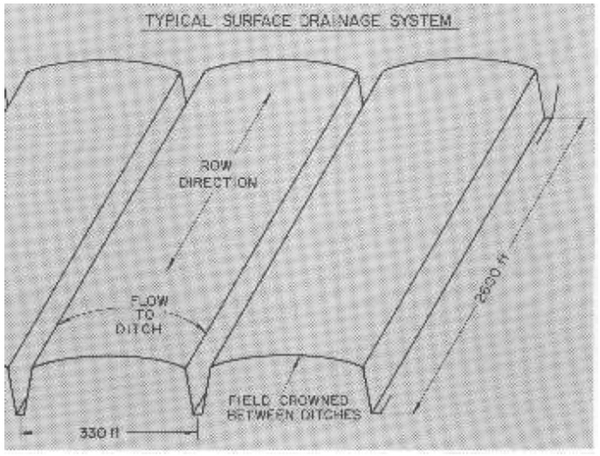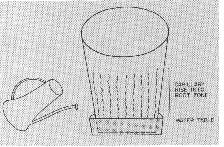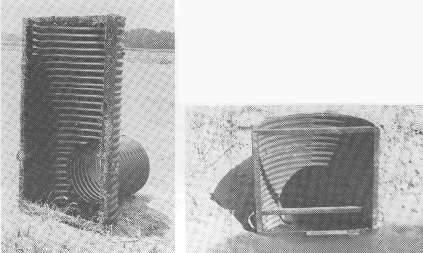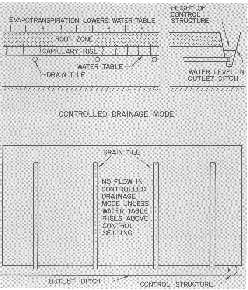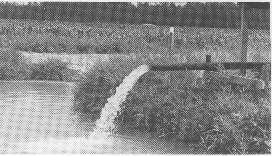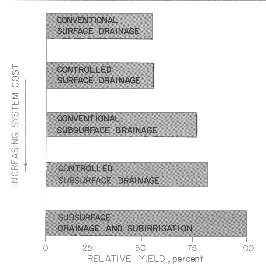Introduction
North Carolina has historically been blessed with an adequate source of good quality water to supply all of its water demands for industry, agriculture and domestic and recreational users. However, if consumption continues to increase at its present rate, water shortages will become prevalent in the near future. Water use in some areas is already approaching critical limits, and shortages in other areas are likely to follow.
The best solution to this increasing demand involves developing management strategies to conserve and use the existing water resources more efficiently. These management strategies can also have a pronounced effect on water quality. Thus, all management decisions should consider strategies that maintain or improve water quality. However, the best management strategies are often geo-graphically sensitive: what might work in one region might not work in another. Each management strategy, therefore, should be selected based on minimizing the specific local problems.
How Water Stress Impacts Crop Production
Soil water, either too much and/or too little, is recognized as the single most limiting factor for crop production in both North Carolina and much of the southeastern United States. This is especially true in the Coastal Plain and Tidewater regions where both excessive and deficient soil-water conditions frequently are found in the same field. These soil-water conditions cause problems for crops grown on about 2.3 million acres of poorly drained soils in North Carolina, soils that make up about 40 percent of the state's total cropland. Yield reductions of more than 50 percent may develop from stress caused by excessive soil-water conditions on these poorly drained soils. This may result either (1) from the inability to plant and tend the crop at the right time due to poor trafficability or (2) from direct damage to the crop when water stands too long in the field. Excess water may also cause nutrient deficiencies due to eventual leaching or denitrification.
On the average, the Coastal Plain of North Carolina receives more than 48 inches of rainfall each year. Since only 36 inches of water are needed to satisfy potential evapotranspiration, this means that there are more than 12 inches of excess rainfall annually. Yet, droughts ranging from a few days up to several weeks occur in most years during June, July and August. Because this is when many crops are most susceptible to deficit soil water, yield reductions take place often. In fact, droughts have produced almost total crop failures in some years even on poorly drained soils. Drought reduces average corn yields by 20 to 30 percent on these traditionally "wet" soils.
Traditional Ways to Reduce Crop Water Stress
Several techniques are available which improve drainage and reduce excess water-related stress. Traditionally in a surface drainage system, open ditches are installed on 300- to 600-foot intervals, and the field is crowned and graded to eliminate potholes (Figure 1). Drop inlet pipes and grassed field borders are needed to minimize ditch-bank erosion which develops when surface water is allowed to enter the ditch uncontrolled. Normally, bedded rows are used to elevate the seedbed and help reduce water stress while the plants are small.
Surface drainage systems require the least initial investment and are often more effective in "tight" clay-textured subsoils; however, maintenance is high and ditch space is nonproductive. Also, high runoff rates characteristic of surface drainage systems contribute greatly to soil and nutrient losses from the field. Subsurface drainage systems using corrugated plastic tubing may also be used to remove excess water (Figure 2). In general, 4- to 6-inch diameter tubing is buried 3 to 5 feet deep at intervals of 50 to 200 feet. These systems are designed to remove approximately one-half inch of water per day (Figure 3). Compared to an open ditch surface drainage system, the subsurface drainage system is initially more expensive and results in greater nitrate transport. But this system's benefits include lower maintenance, less interference with tillage operations and lower peak outflow rates which may be more desirable environmentally.
Many types of above-ground irrigation systems are available to help minimize drought-related stress. These systems range from labor-intensive hand move aluminum pipe systems to self-propelled mechanical move systems capable of irrigating 200 acres in a single pass.
A Dual System Reduces Both Stresses
On poorly drained soils such as many soils found in the Coastal Plain, it may be possible to satisfy both drainage and irrigation demands with one system. Where plastic drainage tubing is installed to provide artificial subsurface drainage, control techniques may also enable water to travel back through the underground tubing to satisfy irrigation needs. This practice is called subirrigation. In contrast, when drainage outlets are managed to conserve drainage water but no additional water is pumped in, the practice is called controlled drainage.
How Subirrigation Works
The process might best be described by seeing what happens when water is added to a flower pot through a shallow pan at its base rather than added from the top of the pot. As Figure 4 shows, when water is added through the bottom, the water rises in the pot through the small passages between soil particles. This is referred to as capillary rise or capillary water. This capillary water becomes available for the plant's use once it rises to the plant's root zone. The height of rise is controlled by the water level in the shallow pan and also the size of the passages between soil particles. Therefore, the height of the shallow pan should be chosen to maintain just the desired distance of the water table from the root zone. Then, if too much water is added to the pot through either the top or bottom, it will overrun the sides of the shallow pan and, consequently, reduce the risk of overwatering the plant. This action would represent the subsurface drainage process.
In the field a structure, such as a flashboard riser is placed in the drainage ditch or tile outlet to control the rate of subsurface drainage (Figure 5). The control structure functions in the same manner as the shallow pan discussed earlier. With this type of system, drainage continues as ]ong as the water table remains in the root zone. On the other hand, once the water table in the field drops below the root zone, which is normally 12 to 18 inches below the soil surface, drainage stops (Figure 6). The water table will continue to recede as the crop removes water by evapotranspiration. Without rainfall or irrigation to replenish this water, the water table will eventually drop too low to supply sufficient water to the crop.
Controlled drainage may save enough water in the soil profile to delay drought stress for a few days. But, in most years, this method will not be sufficient to eliminate all drought stress for the entire growing season.
In order to provide an irrigation function, it will be necessary to add additional water to the system (Figure 7). Rather than adding this water through an overhead irrigation system, the needed water could be pumped into the ditch containing the control structure. This water would move into the field through the underground tubing and maintain a water level as determined by the position of the control structure (Figure 8). (The actual height of the water table needed to eliminate drought stress is a function of the soil and crop but normally will be between 18 to 36 inches from the surface.) The water will then move upward from the water table to the root zone due to capillary rise. This process is known as subirrigation.
How Water Management Impacts Water Quality
Conserving agricultural runoff water offers an added benefit: improved off-site water quality. The three major agricultural pollutants in drainage outflow in North Carolina are pesticides, sediments and nutrients-primarily phosphorus and nitrogen. Coastal counties (such as Hyde and Pamlico) also experience water-quality problems when fresh water is discharged into estuarine areas which are primary breeding and nursery areas for shellfish. Salt water damage to crops may result when high wind tides force brackish water from sounds back through drainage ditches and onto fields.
Several studies have shown that drainage water characteristics can be influenced by the type of drainage system used. For example, a subsurface drainage system will reduce peak flowrates by more than 50 percent compared to a surface system. Subsurface drainage also reduces movement of sediment, phosphorus and pesticides. However, subsurface drainage increases nitrate levels in the drainage water flowing from the site. In these cases it is vital to manage the specific system. For example, controlling the drainage rate on a subsurface system has been shown to reduce the nitrates leaving the site by nearly 50 percent compared to conventional subsurface drainage.
Site Evaluation Is Critical
Subirrigation and controlled drainage practices are not suitable for all sites due to excessive slope, seepage or low permeability. An adequate water supply could also limit subirrigation. Estimates show that over 1 million acres of cropland in North Carolina could incorporate a subirrigation system. On sites where subirrigation can be used, it is probably the best method now available to reduce water-related crop stress. On some sites, however, subirrigation may not be practical, and other alternatives for drainage and/or irrigation should be applied.
Site Requirements for Drainage/Subirrigation
Consider several general site requirements when evaluating the feasibility of a subirrigation system. A drainage/subirrigation system will likely be the most effective and economical alternative on sites which satisfy these general requirements:
- The site needs improved drainage (at least in its natural state).
- The site is relatively flat with a surface slope of less than 1 percent.
- The site has moderate-to-high hydraulic conductivity: Ks > .75 inch/hour.
- The site has a high natural water table or shallow impermeable layer within 10 to 25 feet of surface.
- The site has a good drainage outlet at least 3 feet lower than the average land surface.
- An adequate water supply is available.
Field sites should be evaluated before setting up any water management system. One of the best methods available to evaluate the potential benefits of subirrigation or other water management alternatives is the water management model, DRAIN-MOD, developed at North Carolina State University. This model allows the user to simulate the crop's response (yield) to a water management practice, such as surface or subsurface drainage, controlled drainage or subirrigation. The actual design and sizing of a specific system can also be evaluated. The model evaluation considers such factors as crop, site and soil characteristics, and weather conditions, all of which are important when selecting and sizing a specific system. The model user can then recommend the best water management alternative based on optimizing long-term simulated yields.
Good Water Management Increases Yields
The potential benefits of any water management alternative definitely depend on the severity of the water-related problem. On poorly drained soils in North Carolina, improved drainage will increase long-term average yields by 30 to 50 percent compared to yields without improved drainage (Figure 9). More specifically, one study on Rains sandy loam predicted average corn yields of just over 80 bu/a where a conventional 330-foot open ditch system was used. For good subsurface drainage with drain tubes spaced 80 feet apart, the predicted yield was 135 bu/a.
Irrigation may increase long-term yields an additional 15 to 30 percent on the same soils (Figure 9). Considering the same Rains sandy loam, when the drains were moved closer together (50 feet apart) to provide both drainage and subirrigation, the predicted yield was over 165 bu/a.
Good water management not only increases average yields, it also reduces the year-to-year variation in yield and the risk associated with growing the crop. Finally, undesirable off-site effects can also be reduced by selecting the appropriate alternative.
Seeing Is Believing
Several sites have been established to demonstrate the potential benefit of total water management systems. A fabridam structure was installed on Mitchell Creek in Edgecombe County to control the drainage rate during the growing season. Fields adjacent to the creek have shown a direct response to the structure. For example, corn yields over a three-year period increased an average of 28 bu/a per year in response to the controlled drainage. The structure also conserved over 90 million gallons of water which was used in sprinkler irrigation systems in the neighboring area. One farmer in Scotland County reported an increased corn yield of 40 bu/a per year over a two-year period in response to subirrigation on a 40-acre field.
Seven subirrigation demonstration sites were established recently in Camden, Hyde and Pamlico counties with federal cost/share assistance provided through the Resource Conservation Act. Tours of these sites will be conducted routinely to demonstrate the performance and general operation and management of these systems.
Choose Your System Carefully
As with any water management system, find out which advantages and disadvantages should be considered as part of the evaluation process. Compared to conventional drainage and irrigation systems, a dual drainage/subirrigation system offers the following advantages and disadvantages:
Advantages of Dual Drainage/Subirrigation Systems
- Satisfies both drainage and irrigation needs at lower initial costs;
- Needs less energy, labor and maintenance;
- Lowers operational costs due mainly to reduced energy consumption;
- Conserves rainfall better depending on management strategy;
- Reduces evaporation during water addition;
- Provides less obstructions in the field so operators can continue their cultural practices with no interference;
- Offers more flexibility in managing drainage water;
- Improves quality of drainage water.
Disadvantages of Dual Drainage/Subirrigation Systems
- Lacks potential for frost/freeze protection, crop cooling, chemigation or fertigation;
- Causes underground seepage to surrounding areas;
- Offers poor accessibility for repairs and isolating malfunctions since this dual system is immobile;
- May result in a slower crop response if the soil is very dry.
Seek Professional Advice
Routine Management of any water management practice is vital for the system to perform efficiently and effectively. This is especially true with a drainage/subirrigation system. If you are looking for options that will give you more control over water utilization on your farm, consider this type of drainage/subirrigation system.
But before getting started, first seek trained help. Your county Agricultural Extension Service and Soil Conservation Service are available to help evaluate the potential benefits of any water management alternative for your farm. Their staff has been trained to measure the field properties-such as hydraulic conductivity-necessary to evaluate your site. Drainage/subirrigation equipment suppliers and contractors can also help.
Publication date: June 1, 1996
Reviewed/Revised: July 24, 2024
AG-355
N.C. Cooperative Extension prohibits discrimination and harassment regardless of age, color, disability, family and marital status, gender identity, national origin, political beliefs, race, religion, sex (including pregnancy), sexual orientation and veteran status.

